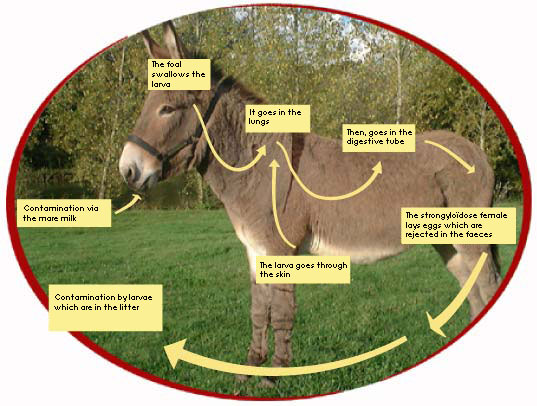|
Treadworms is an intestinal parasitic infection. These
usually only affect foals under six months of age. Strongyloides
are very fine worms of white colour (2 to 9 mm length on 0,05 mm
broad) which parasitize all equids, but we can observe the effects
only on the foal.
| Contamination and cycle of
life |
 |
Dormant infestations in pregnant mares are transmitted to foals
via the milk, or by Strongyloides westeri's larvae present in the
external environment which are swallowed directly, or which penetrate
in the skin.
The parasite carries out then several migrations (in the lungs,
the bronchial tubes, then swallowed again), to finish in the intestine.
The larva become adult and females will lay eggs which will be rejected
in the faeces.
However, a great number of these larvae will migrate in the mammary
glands of the mare, and will go in the colostrum and milk.
Also, a foal just born can be contaminated in the first day of
its life.

Life cycle of Strongyloides
westeri
| Symptoms |
 |
If the new born foal is contaminated it will have severe diarrhoea
of greenish colour without fetid smell between the 9th and the 13th
day of its life. This diarrhoea is accompanied by a strong dehydration,
lose of weight and anaemia which will result in death.
In the adult donkeys, the effects are very, or non existant.
| Prevention - Treatment |
 |
The majority of the wormers are effective against this parasite.
It is advised to worm the mare the day before the foaling. If the
new born foal is contaminated, repeated worming every two weeks
are necessary. And, cure also for dehydration must be made.
|










